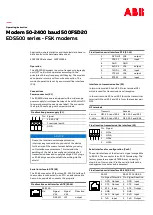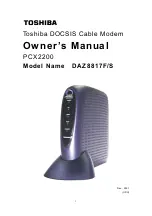
Alarm relay (X4)
The devices are equipped with a potential free alarm
output (relay with isolated switchover contact). This
output corresponds to a device alarm and is activated
when the device looses the power supply or the alarm
LED is constantly on. The reason for the signaling of an
alarm can be referenced in the system alarm table.
Pin allocation alarm output (X4)
Pin Signal
1 & 2 Normal state
1 & 3 Alarm state
1
2
3
4
4
Common contact (connected to 1)
WARNING
The relay is designed for switching only safety extra
low voltages.
Signaling
LED
Description Function
off
Device is without
power supply
Power
Voltage
Supply
green
Power supply
switched on
off
DTE does not
send
RTS
Request to
send
green
DTE requests
to send via the
modem
off
CTS inactive
CTS
Clear to
send
green
The CTS is
switched on when
the carrier is
being established.
A transmit delay
time of 20-30ms
has to be adjusted
in DTE settings.
off
No signal received
DCD
Data carrier
detected
green
Modem signal
received
off
good signal
quality level
SQL
Signal
quality level
alarm
red
•
signal quality
(SQ) below the
SQ threshold
more than 10
times within 4
seconds
•
no carrier is
detected for
more than
a baudrate
dependent
time
off
tranmitter/
receiver test
function inactive
EQZ
Equalizer
flash
yellow
0 Hz = best result
25 Hz = worst
result
LED
Description Function
off
No activity on the
Con0 interface
Con0
Con0
activity
green
Data is trans-
mitted via Con0
off
No alarm
flash
Warning or
configuration
error
Alarm
Alarm
red
Alarm
Configuration using a serial configuration cable
The serial interface provides access to the command
line. Using a serial configuration cable (500CAB06
1KGT038912R0001), the device can be connected to a
serial port of a PC/notebook.
The default configuration for the serial connection is:
57600 Baud 8N1 (8 data bits, no parity, 1 stop bit), no
hardware flow control.
The command line interface
The command line of the 500FSD20 is similar to the
(DOS) command line known from the PC. All device
properties can be set and shown here.
•
Commands are typed into the console, pressing
< { E n t e r } >
will start execution.
•
Commands can be abbreviated as soon as they
are unambiguous, i.e.
< s h s y >
is equivalent
to
< s h o w s y s t e m >
,
< s e i f w 4 >
is
equivalent to
< s e t i n t e r f a c e f s k 0 w i r e
4 >
.
•
A command overview can be listed on every level
by typing
< ? >
. Example:
< s h a l ? >
translates
to
< s h o w a l a r m ? >
and results in
a c t i v e
e n a b l e d
being shown as command keywords
to follow, i.e. one possible command is
< s h o w
a l a r m a c t i v e >
.
•
There are two authentication levels on the
command line: Login authentication and Enable
authentication. Login authentication can be
described as a read only mode and is accessible
directly after establishing a serial connection
with the PC. Enable authentication is required
once you need to change system settings or
show the complete system parameter set.
Enable authentication is reached by entering
command. Both authentication
levels can be protected by a password, the
.
























